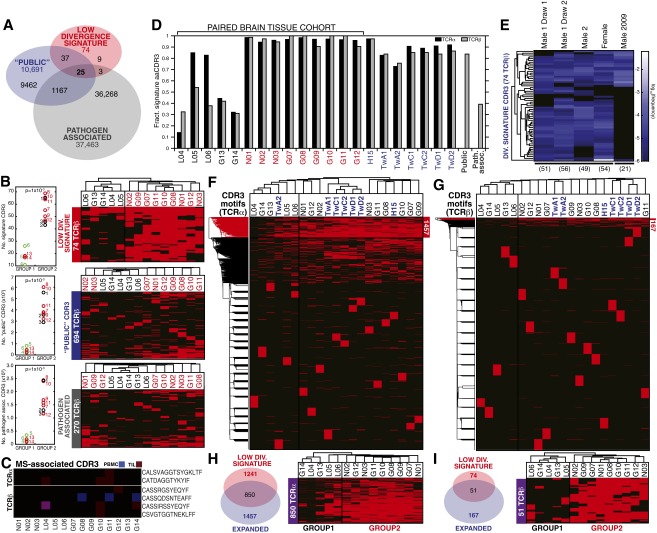Fig. S5.
Distribution of CDR3 motifs of the low-divergence signature and previously published specificities. (A) Overlap among 10,691 public TCRβ CDR3 amino acid motifs described by Britanova et al. (21), 37,463 TCRβ CDR3 compiled from several studies for association with common pathogens, and our signature set (74 TCRβ CDR3, SI Materials and Methods). (B) (Left) Significantly higher numbers of signature (Top), public (Middle), and pathogen-associated CDR3s (Bottom) were observed in the TCRβ PBMC repertoires of group 2 patients than of group 1 patients (P = 1 × 10−3 for all CDR3 sets, Wilcoxon rank sum). (Right) The top use TCRβ CDR3 motifs (as in Fig. 4B) were filtered on the signature set (Top), the Britanova et al. (21) public set (Middle), and the pathogen-associated CDR3 set (Bottom) and patients hierarchically clustered by their presence and absence. (C) Among CDR3 motifs previously associated with targeting myelin-basic protein in MS patients (9 TCRα, 81 TCRβ; SI Materials and Methods), six were observed in our cohort (frequency ≥10−5), as indicated by patient (x axis) and tissue (blue, PBMC; red, TIL; and purple, both). (D) The fraction of the signature CDR3 (1,241 TCRα, 74 TCRβ) observed in PBMC of group 1 (black), group 2 (red), and additional healthy human subjects (blue), as well as the public and pathogen-associated sets (gray). (E) Signature CDR3 motifs were observed in TCRβ repertoires of healthy individuals sequenced using a different method in two studies (black lines, SI Materials and Methods) at frequencies ≥10−6 (heat map). (F and G) The top 1,000 most abundant CDR3 motifs (frequency ≥10−5) were compiled from the 14-patient cohort, subject H15, and additional healthy subjects (16,564 TCRα, 20,395 TCRβ) and hierarchically clustered by presence or absence of these CDR3 motifs (y axes) across samples (x axes). (H and I) Overlap between the TCRα and TCRβ CDR3 clusters stratifying the 21 PBMC repertoires (F and G) and the signature sets (Left). Hierarchical clustering of the paired brain tissue cohort with respect to the presence or absence of these overlapping CDR3 motifs recapitulated the initial group 1 and group 2.

